Draeger Dolphin
Semi-Closed Circuit Active //
1 August
READ THIS FIRST!
| Name: | Dolphin (Atlantis) |
| Manufacturer: | Draeger |
| Website: | http://www.draeger.com/ |
| Since: | 1997 |
| Type: | SCR, active (constant mass flow), three nozzles |
| CE: | Yes |
| Lungs: | Backmounted |
| Weight: | 19 kg |
| Scrubber duration: | 3 hours (Draeger Divesorb) |
| Weight Scrubber: | 2.5 kg |
| ADV (Automatic Diluent Valve): | Standard (by-pass) |
| HUD (Head Up Display): | No |
| BOV (Bail Out Valve): | No |
| (Deco-) computer: | No (PO2 monitor is optional) |
| Tanks: | 4 ltr (one with M24x2 thread) |
| My deepest dive with the unit: | 55 mtr |
| Price: | N/A (only second hand available) |
| General: 3 stars | The Draeger Dolphin was firstly introduced as Atlantis. The unit is based on a military unit. It makes use of constant mass flow technology. It means that a nitrox mixture is “injected: into the loop with a constant flow. The Dolphin has standard three “nozzles”. For 32%, 50% and 60%. The flow speed is in such away that there will be 2 ltr oxygen per minute injected into the loop. That should be enough for an average O2 consumption. If not: the by-pass will be activated. This type of rebreather is called “active” because the diver doesn’t need to inhale to get a flow of gas. I like the dolphin. Unfortunately the Dolphin hasn’t become a big success. PADI tried to make it the first recreational rebreather. Now the Dolphin can only be bought second hand (very cheap). At the introduction the Dolphin was about 400 EUR. A lot of Dolphins have been transferred to mCCR. |
| 1. Ease of use (set-up, maintenance): 3 stars | Easy to set up. Although it requires some exercise to mount the lungs and the canister. Difficult to make mistakes. |
| 2. Buoyancy/trim: 3 stars | Trim is reasonable. There are several weight pockets in the BCD of the unit. |
| 3. WOB: 4 stars | WOB is very good. Lungs are close to the body. Breathing hoses are wide. Lungs are on the back. That leaves an open chest. |
| 4. Travel (modularity): 3 stars | Easy to travel with. Although the M24x2 thread of the first stage makes putting other tanks difficult. The max size of a tank is 5 ltr. Otherwise the buoyancy becomes difficult. |
| 5. Safety: 2 stars | There are no safety options. Only a small of borad bailout tank (optional). A PO2 monitor. Draeger provides the Oxygauge (with one cell): a bad monitor. Difficult to calibrate and operate. Better is the (wireless) Uwatec. But it is quite expensive. But on the other hand: does one need a monitor on (active) SCR? I think one needs one when gas switches are done. But this is not possible on a (non-modified) Dolphin. |
| 6. Price: N/A
| Only available second hand. |
| 7. Service: 1 star | Spare parts are still available. The Draeger organization was not prepared for a retail market. That’s why to sold it to Aqualung. But Aqualung didn’t market the Dolphin anymore. |
| 8. Build quality: 4 stars | Draeger Quality. |
| 9. Cave diving: 1 star | Only suitable for recreational diving. |
| 10. Deep and X-treme diving: 1 star | Only suitable for recreational diving. |
